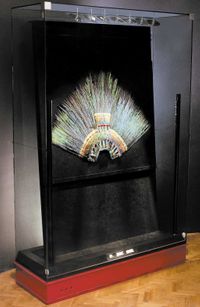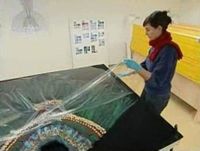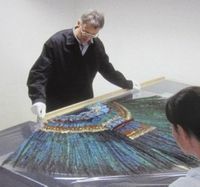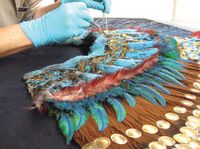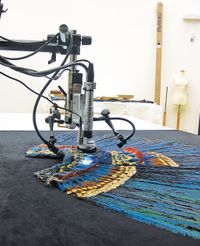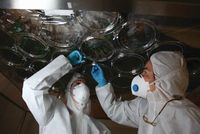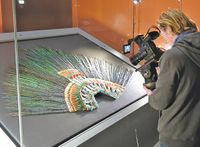Restorations
The first intervention in the substance of the crown probably took place before 1596. Long green feathers may have been removed in order to integrate them into a horse headdress!
The “golden helmet” was “somehow lost” after 1730!!!
Numerous transports have led to a deterioration in the condition.
The first documented restoration was carried out by Christine von Luschan in 1878 shortly after the transfer from the Ambras collection. Numerous remains of feathers with insect damage were covered with other feathers, these were fastened with yellow thread, 373 metal elements made of gold-plated brass were added. So gold had been removed again!
It was assumed that the crown was a standard. This should be presented flat. A white stiff fabric was therefore inserted to give the object more stability. In order to insert the fabric, parts of the original material (light blue feathers glued to paper supports and a textile underneath) were cut and moved slightly.
The fabric and the metal elements were also fixed with the yellow thread.
There are glue residues (animal glue) at various points on the object, with which individual feathers and skin fragments were attached to the substrate (textile, leather, or remnants of the original feathers).
Numerous long green feathers that had broken off were cut in the shape of an arrow and tied to other feathers with the help of brown threads. Poorly preserved tips were removed and the feathers cut to the required length.
The long green feathers were connected in places with a thick brown thread. This has led to significant deformation of individual spring flags. The needles that have probably been used since this year to fix the crown on the ground have led to punctures in the quills and deformation of parts of the feather.
The blue feather areas were badly damaged. Since there were not enough kotinga feathers available, feathers from the kingfisher from East India were used.
The blue feather areas were badly damaged. Since there were not enough kotinga feathers available, feathers from the kingfisher from East India were used.
After the storage in the safe during the war (until 1947) and the exhibition in Zurich, severe damage was found, including the internal structure. The exact damage and the measures taken against it are not documented.
Since the 1960s at the latest, pesticides have been used to protect against insect infestation. Mothballs were sprinkled regularly and evaporated over time.
During a relocation in 1992, which had to take place in a single afternoon, the crown was "astonishingly stiff". Two long green tail feathers came loose, one was reattached with superglue, the other fixed with needles. A piece of black-colored foam was placed in the middle under the main part to support the area and create a plastic effect.
Showcase with motion detector from 1994
Investigation / Restoration 2010 to 2012:
"In a scientific cooperation agreement, the will to make a joint effort in the preservation, study and worldwide communication of the historical and cultural significance of this emblematic object, which is shared as the cultural heritage of Mexico and Austria, was expressed."
In 2009, the Mexican and Austrian side began to jointly carry out the condition assessment, examination and conservation of the feather crown. The first visit to Vienna by the General Director of the INAH (National Anthropological Institute), Alfonso de Maria y Campos, the Mexican academic delegation, where the representatives of Mexico and Austria made their acquaintance, took place in February 2010. A one-week working meeting and scientific discussion Numerous other working meetings followed.
Participants in the first meeting:
Igor Ramirez Garcia-Peralta - Melanie Korn - Lilia Rivero Weber - Maria de Lourdes Navarijo - Maria Olvido Moreno Guzman - Salvador Guillien - Christian Feest - Gerard van Bussel.
Activities:
- High-resolution photographic recordings, different angles and lighting conditions, including with UV light, systematically photographed from about 15 cm.
- Examined with a 3D microscope.
Since it was not possible to transfer the bed to the front, the crown was moved onto a glass plate with the help of a polyester film (!), Inspection and photographs of the back. (VIBRATIONS!)
Then transferred to another plate, which was provided with round, removable openings, so that access to the rear was possible. (VIBRATIONS!)
